How to Grow and Care for Everbearing Strawberries
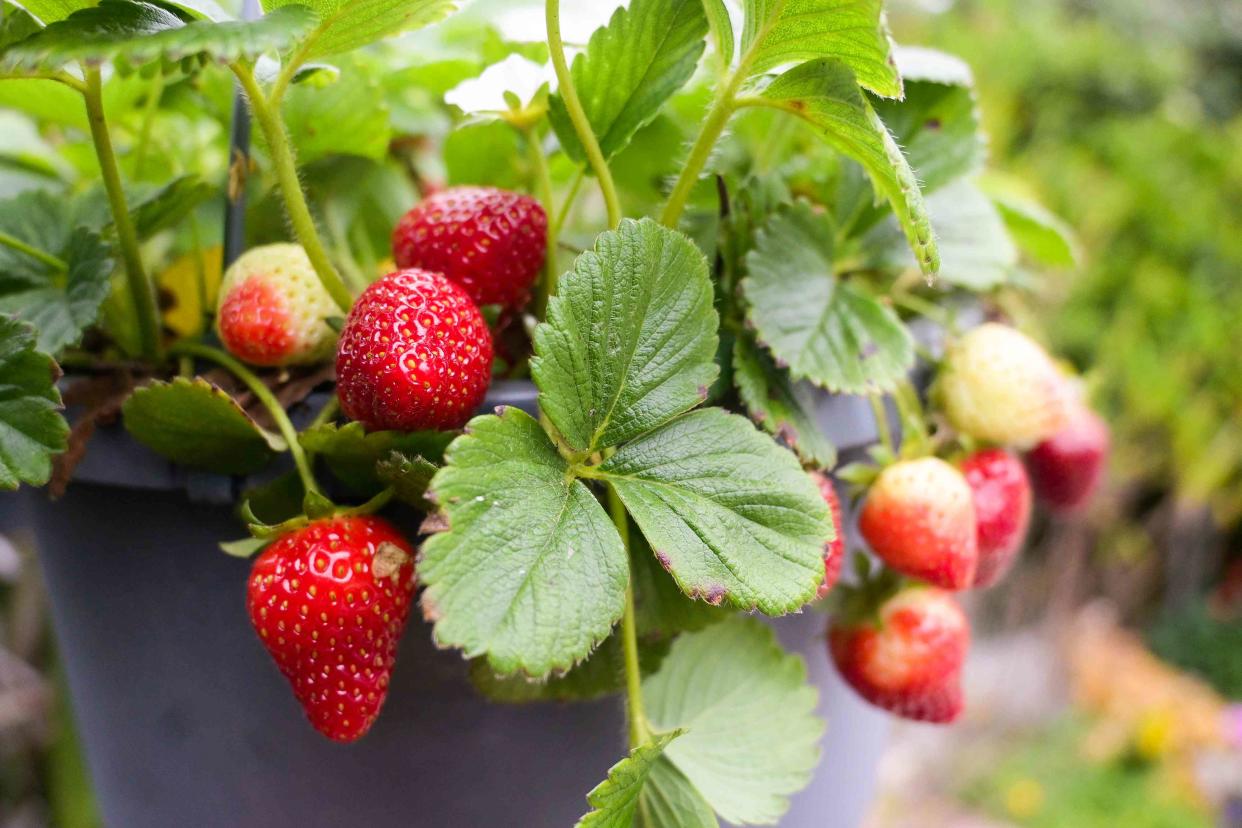
The Spruce / Randi Rhoades
Reviewed by Kathleen Miller
The only thing better than strawberries eaten right off the plant is strawberries eaten right off the plant two or three times a year. That is what you get when you plant everbearing strawberries. Good for at least two harvests a year, some growers may get three in perfect conditions. Though a bit trickier to grow than the average strawberry plant, the abundance of fruit you get from everbearing strawberry plants (Fragaria x ananssa 'Quinault') is worth the effort.
Common Name | Everbearing strawberries |
Botanical Name | Fragaria × ananassa 'Quinault' |
Family | Rosaceae |
Size | 8-10 in. tall, 12-18 in. wide |
Sun Exposure | Full sun |
Soil Type | Rich, well-draining, moist |
Soil pH | Neutral |
Bloom Time | Spring, late summer, fall |
Hardiness Zones | 3-10 (USDA) |
Native Area | Cultivar, no native range |
How to Plant Everbearing Strawberries
When to Plant
To get the most out of every day of the growing season, you want to get your everbearing strawberries into the ground as soon as possible. For everbearing strawberries, a good timeframe is usually a few weeks before the last frost. If you live in a particularly cold area, you may want to wait until your evening temperatures are consistently above 45 degrees Fahrenheit.
Selecting a Site
When planting your everbearing strawberries, you should find a spot that gets full sun but is guarded against the afternoon sun. The dappled afternoon sun is okay, but the leaves of your plants will burn in the harsh sun in the hottest months of the year.
It is also a good idea to keep the area where you plan to plant somewhat manageable; you do not want a sprawling strawberry patch. Give your plants enough room to spread out and for you to wander about to harvest and care for your plants, but giving it much more room than that will result in constant weeding.
Spacing and Depth
Strawberries are small plants, but they like to spread a lot. They put out runners, which are a great way to get more plants but the small plants soon spread out much wider than they are taller. Because of this, it is important to plant them with plenty of room to spread; 15-20 inches between each plant should suffice. As for planting, you will want to dig the hole twice as wide as the plant's rootball and trim off the dangling roots when the plants are removed from their nursery pots.
An easy way to guarantee you have enough room for each plant and plant each everbearing strawberry plant deep enough is by planting them in containers. This also allows you to place them in areas with the right sun at the perfect time.
Everbearing Strawberry Care
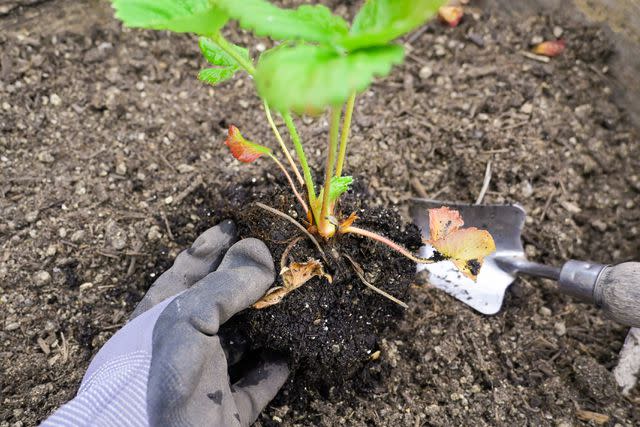
The Spruce / Randi Rhoades
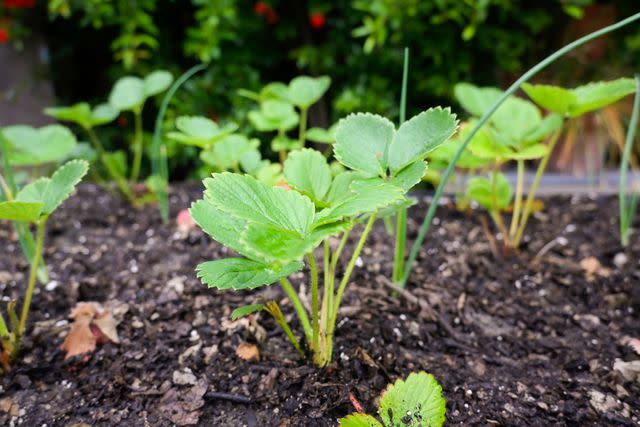
The Spruce / Randi Rhoades
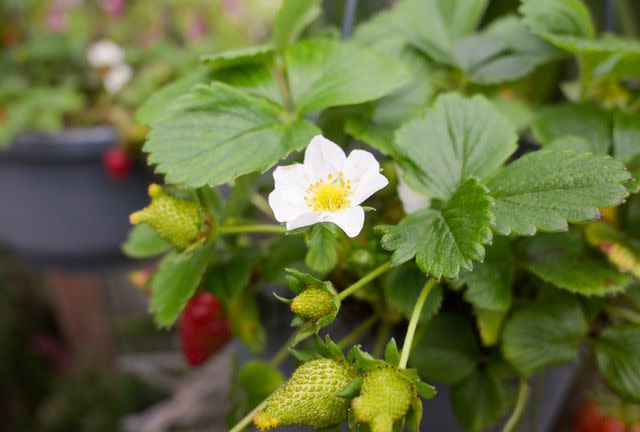
The Spruce / Randi Rhoades
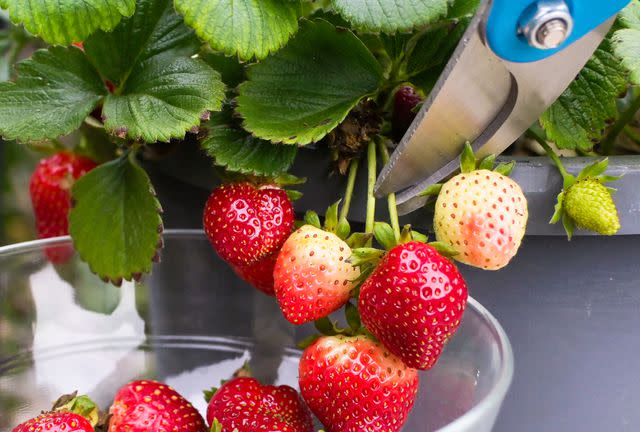
The Spruce / Randi Rhoades
Light
You want to provide a spot in your garden that gets full sun for your everbearing strawberries. At the same time, it should be mentioned that this needs to be tempered by limiting the amount of direct afternoon sun the plants get. Aim for the dappled sun in the afternoon to avoid scorching the plants' delicate foliage and ensure you continue to get harvests throughout the summer into the fall.
Soil
The soil that your everbearing strawberries are planted in is very important. You need to give them the best possible soil to deliver abundant amounts of those delicious sweet strawberries. Aiming for organically rich soil that is well-draining is ideal. The pH should be as close to neutral as possible, which means testing may be needed before planting and adding some amendments to increase or decrease acidity or alkalinity as necessary.
Water
Juicy strawberries are the best; there is no disputing that, and that juiciness comes from ensuring that your everbearing strawberries get plenty of water. An inch of water per plant, in general, will keep those plants happy and healthy and produce that juicy fruit everyone loves. The one thing you need to make sure of is that your soil drains well, as strawberries are susceptible to root rot.
Temperature and Humidity
The temperature and humidity are not so much a factor in the success of everbearing strawberry plants, as is the amount of sun and irrigation they get. If you provide a well-sheltered area in a warm area and plenty of supplemental irrigation, your strawberries should do okay but may not give you the full three harvests they can.
Keep with the recommended USDA hardiness zones of 3 through 10, provide sufficient shelter from the harsh sun, and supply your plants with plenty of irrigation so they should thrive.
Fertilizer
It is best to provide your plants with all the fertilizer they need before planting by mixing in 1 to 2 inches of compost to your soil while preparing your garden bed. If you feel fertilizing your plants mid-season is necessary, go with an all-purpose 10-10-10 fertilizer.
Harvesting Everbearing Strawberries
With proper care and the right conditions, you may be able to harvest your everbearing strawberries at three points during the season: spring, late summer, and fall.
Picking your harvest is important as it prepares your plant for its next bounty. You want to remove fruit that is bright red and large. Any fruit that seems too small and lingering at immaturity should be removed. Your goal is to harvest as much fruit in as small a window and get your plant focused on producing more blooms, which produces more fruit.
While doing this, you will notice your plants will set off runners; these should be removed to allow your plants to put all energy into producing fruit. These runners can be planted into pots and saved until the next season indoors.
Growing Everbearing Strawberries in Pots
A great way to grow everbearing strawberries is by collecting the runners planted in soil. When you grow everbearing strawberries from runners, you can skip the planting in the soil step completely and plant directly in pots with complete success.
Plant one plant per large pot, allowing room for it to spread; avoid premade strawberry pots as they do not provide much room. It is also a good idea to avoid terracotta pots as they will increase the amount of water needed, which will already need to be doubled since soil in pots does not retain the same amount of moisture that it does in the ground.
Overwintering
Depending on where you are located, you may be able to keep your plants over the winter directly in the soil if you do not get especially cold winters. There are conflicting reports that Fragaria × ananassa 'Quinault' is frost resistant, but most information points to them not being hardy enough to withstand winters in cold locations.
The best bet in these situations is to take cuttings of your runners, pot them, and bring them inside over the winter and either plant or keep them potted for the next season.
Common Pests and Plant Diseases
There is no shortage of diseases and pests that attack strawberries, and everbearing strawberries are no exception. You may run across various foliage diseases, root rots, wilts, viruses, and scorch. The best you can do is keep looking for symptoms and remain proactive by giving the best care to your plants which may limit any possible health issues.
Unfortunately, even the best conditions and care will not keep the most stubborn pests away. For this, you need to be the first defense and constantly look over your plants to notice any evidence of signs or symptoms that you may have unwanted visitors. Most often, strawberries will be bothered by slugs, aphids, strawberry weevils, and various mites. Each pest can usually be treated fairly easily, with most not causing too much of an issue if caught early enough.

